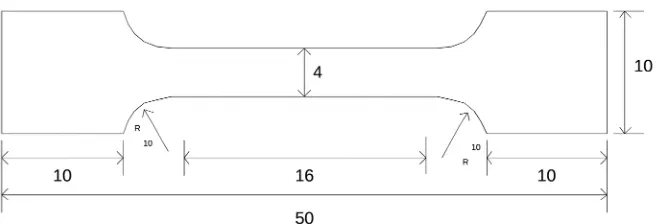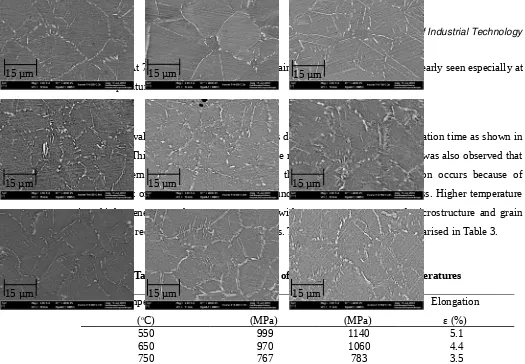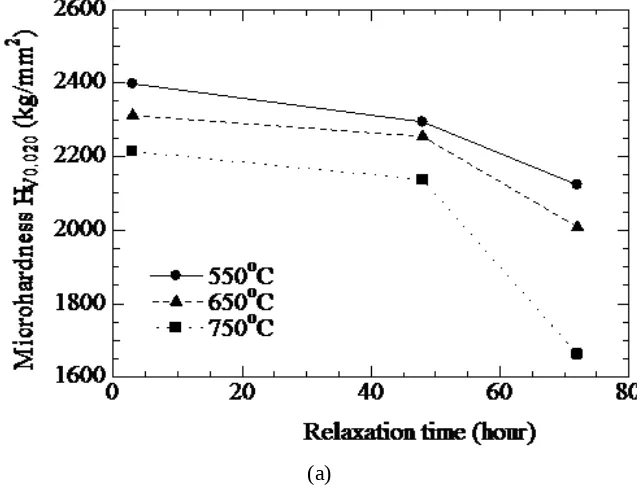STRESS RELAXATION BEHAVIOUR AND MECHANISM OF HEAT
TREATED INCONEL 718 IN HIGH TEMPERATURE ENVIRONMENTS
O. Bapokutty1, Z. Sajuri2 and J. Syarif2
1Department of Structure and Material, Faculty of Mechanical Engineering,
Universiti Teknikal Malaysia Melaka, Hang Tuah Jaya, 76100 Durian Tunggal, Melaka, Malaysia.
2Department of Mechanical and Materials Engineering,
Faculty of Engineering and Built Environment,Universiti Kebangsaan Malaysia, 43600, UKM Bangi, Selangor, Malaysia.
RINGKASAN: Kelakuan tegasan santaian bagi superaloi berasaskan nikel iaitu Inkonel 718 terawat haba telah dibuat kajian pada suhu tinggi. Rawatan larutan telah diperkenalkan kepada bahan diterima pada suhu 980 oC selama 1 jam sebelum dikenakan lindap-kejut dengan air, seterusnya bahan tersebut
melalui proses penuaan berganda pada suhu 720 oC selama 8 jam dan 621 oC selama 8 jam dan
disejukkan dalam udara pada suhu bilik. Ujian tegasan santaian telah dilakukan dengan terikan 1 % pada suhu yang berbeza iaitu 550 oC, 650 oC dan 750 oC. ujian dijalankan selama 72 jam. Ujian
dihentikan pada 3 jam dan 48 jam bagi mengkaji evolusi mikrostruktur dan perubahan dalam sifat-sifat bahan melalui penggunaan Mikroskop Imbasan Elektron dan Pembiasaan Sinar-x. Keputusan menunjukkan tegasan bergantung suhu meningkat dengan penurunan suhu. Sebaliknya, kadar tegasan santaian bertambah dengan pertambahan suhu. Pemerhatian mikrostruktur menunjukkan proses pemulihan berlaku. Ianya disokong oleh pengurangan ketumpatan kehelaan dengan pertambahan masa dan suhu, yang mana dipersetujui dengan keputusan kekuatan-mikro Vicker.
ABSTRACT: The stress relaxation behaviour of heat treated nickel-base superalloy Inconel 718 at high temperature was investigated. Solution treatment was applied on the as-received material at 980 oC for 1 hour before water quenching followed by double aging treatments at 720 oC for 8 hours
and 621 oC for 8 hours, then cooled in air.The stress relaxation test was conducted at 1 % strain at
different test temperatures of 550 oC, 650 oC and 750 oC. The tests were carried out for a total of 72
KEYWORDS: Heat treatment, stress relaxation, recovery, microstructure, Inconel 718
INTRODUCTION
Inconel 718 is a nickel-based superalloy extensively used in fabrication of critical components for turbine because of its excellent mechanical properties at elevated temperatures and good corrosion resistance. Application of this alloy range from disc alloy in gas turbine engines to components used in nuclear and cryogenic structures, high-strength bolts and fasteners, and components in space craft, owing to its excellent fabricability and weldability (Kim et al., 2008). In the turbine disc application, standard processing, high strength processing and direct age processing have been applied in order to achieve the desired properties (Nowotnik et al., 2008). Gas turbine blades are commonly made of Inconel 738LC alloy (Mazur et al., 2005). Blade-disc fixing in turbine engine are highly loaded connections that allow only micrometer size relative movement between blade and disc. Initially, stresses were intentionally introduced at a desired level to hold the blade firmly. However, at high temperature environment, relaxation of such stresses can result in loss of tension in fitting and cause undesirable vibration (Pan and Xiong, 2010). Therefore, the aims of this study are to investigate the stress relaxation behaviour and mechanism of heat treated Inconel 718 in high temperature environments.
MATERIALS AND METHODS
The material used in this study was nickel-base superalloy Inconel 718. The chemical composition of the material used is as follows: Ni 55.83 %, C 0.033 %, Fe 15.51 %, Cr 17.58 %, Cu 0.0293 %, Mo 3.522 %, Co 0.238 %, Mn 0.005 %, Al 1.032 %, Nb 5.189 %, Ti 1.103 % and Si 0.08 %. The geometry of the specimens used is presented in Figure 1 with a thickness of 3 mm. To increase the strength of Inconel 718 after sample preparation by Electrical Discharge Machining (EDM), standard heat treatment process was introduced to the samples (Ghosh et al., 2008; Liu et al., 2005; Kuo et al., 2009; Xiao et al., 2008). Samples were annealed at 980 oC for 1 hour before quenching in water.
Samples then underwent double aging treatment process at 720 oC for 8 hours and 621 oC for 8 hours.
Finally, the samples were cooled in air to room temperature.
Stress relaxation tests were conducted at three different test temperatures of 550 oC, 650 oC and
750 oC with same strain level of 1 %. The tests were carried out for 3, 48 and 72 hours. Prior to the
stress relaxation tests, tensile properties of heat treated Inconel 718 at elevated temperatures of 550 oC, 650 oC and 750 oC were identified.
Figure 1: Test specimen dimension (in mm)
Metallographic sections were prepared using standard mechanical polishing procedure. Samples were then etched using Kalling Reagent No. 2 and studied by means of SEM. The micro-hardness of specimens was investigated using Vickers micro-hardness tester by using a 20 gram force (Hv0.020) to
all samples that underwent relaxation tests. The dislocation density of specimens was evaluated by
XRD to provide the evidence of recovery. The dislocation density is thus defined as:
ρ = (1.44 x ε2) / b2
where b is the Burgers vector (0.25 nm) and ε is strain broadening (Syarif et al., 2007).
RESULTS AND DISCUSSION
Figure 2(a) and Figure 2(b) show the stress-strain and stress-time (stress relaxation) curves of the heat treated Inconel 718 at different temperature levels, respectively. From Figure 2(a), the tensile properties at different temperatures are summarised in Table 1. Figure 2(b) showed that thermal dependent stresses required to obtain 1 % strain were 1050, 1000 and 583 MPa at temperatures of 550 oC, 650 oC and 750 oC, respectively. These values were lower compared to the ultimate tensile
strength. Figure 2(b) shows two distinguishable regions of stress relaxation rate; the accelerated region from the beginning up to 15 hours followed by the steadily and constantly reduced stress relaxation rate until the tests end. The slope of constantly reduced stress relaxation or calculated mean stress relaxation rates were 1.0531, 1.0713 and 1.6923 MPa/hour for 550 oC, 650 oC and 750 oC test
conditions, respectively. After 72 hours, the measured internal stresses were 730, 443 and 69 MPa for 550 oC, 650 oC and 750 oC test conditions, respectively. These results are summarised in Table 2.
(a)
(b)
Figure 2: (a) Stress-strain and (b) stress relaxation curves
The SEM micrographs for heat treated Inconel 718 tested at different temperatures are shown in Figure 3. After 3 hours of stress relaxation test, the grain boundaries were still intact and clearly seen with very little deformation at grain boundary. As shown in Figure 2(b), accelerated phase occurs at the beginning of the test. After prolonging the test beyond 20 hours, the creep-controlled mechanism started to dominate the behaviour where recovery process started to occur until the end of the stress relaxation test. These mechanisms of recovery are shown at 48 hours in the micrograph in Figure 3 where rearrangement of microstructure and grain boundary occur which give impact of blurring in
micrograph. At 72 hours, where tests ended, grain boundaries are visible and clearly seen especially at lower temperature.
The average values of Vickers micro-hardness decreased with increasing relaxation time as shown in Figure 4 (a). This was believed to be due to the recovery at grain boundary. It was also observed that increase in temperatures will further reduce the hardness. This phenomenon occurs because of rearrangement of microstructure and grain boundary with effect on the hardness. Higher temperature gives higher energy to the recovery process with more rearrangement of microstructure and grain boundary and reduced hardness of the materials. The hardness results are summarised in Table 3.
Table 1. Mechanical properties of Inconel 718 at various temperatures
Temperature
Table 2. Thermal dependent, internal and calculated mean stresses relaxation rate
Figure 3: SEM micrographs after relaxation test for 3, 48 and 72 hours
Figure 4 (b) shows the decrease of dislocation density with increasing relaxation time and further decrease by increasing temperature. Detail results are summarised in Table 4. From Figure 4 (b) the recovery rate for each temperature condition was calculated and tabulated in Table 5. It was found that lower dislocation density gives lower Vickers micro-hardness and vice versa due to recovery process.
(a)
Page 6 of 9
48
h
ou
rs
72
h
ou
rs
(b)
Figure 4: (a) Micro-hardness vs time and (b) dislocation density vs time
Table 3.Vickers micro-hardness
Time(hour) Temperature(oC)
550 650 750
3 2398 2294 2123
48 2311 2254 2008
72 2213 2137 1662
Table 4. Dislocation density
Time(hour) Temperature(oC)
550 650 750
3 3.78E+15 1.07E+15 2.54E+14
48 1.81E+15 6.27E+14 9.73E+13
72 5.54E+14 5.31E+13 3.35E+12
Table 5. Recovery rate
Recovery rate (m-2/hr)
Time(hour) Temperature(oC)
550 650 750
3-48 4.38E+13 9.84E+12 3.56E+12
48-72 5.23E+13 2.39E+13 3.77E+12
In this study, stress relaxation behaviour of Inconel 718 has been studied at different temperatures.
The difference in temperatures gives impact on stress relaxation rate, difference between internal and
thermal dependent stresses, dislocation density and Vickers micro-hardness. Increasing temperature
will increase stress relaxation rate of Inconel 718 at 1 % strain. Increasing temperature will also
increase the differences between the internal and thermal dependent stresses. The dislocation density
and Vickers micro-hardness decreased (evidence of recovery) with increasing relaxation time and
further decreased by increasing temperatures.
REFERENCES
Ghosh, S., Yadav, S. and Das. G. (2008). Study of standard heat treatment on mechanical properties of Inconel 718 using ball indentation technique. Materials Letters. 62(17-18): pp 2619-2622.
Kim, D-H., Kim, J-H., Sa, J-W., Lee, Y-S., Park, C-K. and Moon, S-Il. (2008). Stress rupture characteristics of Inconel 718 alloy for ramjet combustor. Materials Science and Engineering A. 483– 484: pp 262–265.
Kuo, C.M., Yang, Y.T., Bor, H.Y., Wei, C.N. and Tai, C.C. (2009). Aging effects on the microstructure and creep behaviour of Inconel 718 superalloy. J. Materials Science and Engineering. A 510-511: pp 289-294.
Liu, L., Zhai, C., Lu, C., Ding, W., Hirose, A. and Kobayashi, K. F. (2005). Study of the effect of δ phase on hydrogen embrittlement of Inconel 718 by notch tests. Corrosion science. 47: pp 355-367.
Mazur, Z., Luna-Ramirez, A., Juarez-Islas, J.A. and Campos-Amezcua, A. (2005). Failure analysis of a gas turbine blade made of Inconel 738LC alloy. Engineering Failure Analysis. 12, pp 474–486.
Nowotnik, A., Sieniawski, J. and Mrowka-Nowotnik, G. (2008). Identification of dynamically precipitated phase in hot-working Inconel 718 alloy. J. of Achievements in Materials and Manufacturing Engineering. Vol. 31, Issue 2: pp 275-280.
Pan, Y. and Xiong, D. (2010). Stress relaxation behaviour of nano-hydroxyapatite reinforced poly(vinyl alcohol) gel composites as biomaterial. J. Mater. Sci.. Volume 45, Number 20: pp 5495-5501.
Syarif, J., Nakashima, K., Tsuchiyama, T. and Takaki, S. (2007). Effect of solute copper on yield strength in dislocation-strengthened steels. The Iron and Steel Institute of Japan International. Vol. 47, No. 2: pp 340-345.




